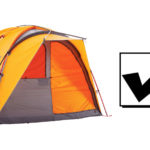Camping on a cold winter’s night is a completely different experience from camping during the warmer months, and because of this, you need to be prepared.
With this in mind, it’s a good idea to know how to insulate your tent, so you can keep the warm in, and keep the cold out.

How to Insulate a Tent for Winter Camping? - Detailed Guide
In order to insulate your tent, you need to create a barrier that will reduce the transfer of heat between one material to another.
This is done by reducing the radiant effects and conduction, and, you might be surprised to hear it, but your body is going to be the main source of heat that we’ll be looking to insulate.
How to Insulate a Tent Floor?
First thing’s first, you’ll want to source an air-trapping material, and why not kill two birds with one stone and find an insulating material that will also reflect your body heat back to you?
For example, heavy-duty reflective foam, which you can buy on Amazon.
This foam reflects 97% of radiant heat and emits less than 3% of heat, but it also takes the “trapped air” technique to the next level by using trapped gases (that are safe for people) that are even less dense than air.
This foam is best used to insulate the tent floor, and you can find some tips for doing this below:
- When you cover the floor with your reflective foam, ensure you cover not just the footprint of the tent but 5 inches of the walls too, in order to reduce cold air currents.
- Avoid using a raised bed, as cold air will move under the raised bed, and could start to transfer heat. An air mattress is a great option; not only is it one of the more comfortable options, but it will act as one big air pocket to barrier the cold air.
- A heating carpet is a great way of adding more warmth to your tent floor if you have the luxury of a power source. This also works really well if you combine it with the reflective foam.
How to Insulate a Tent Walls?
The walls of the tent have the most contact with the cold air, and because the warm air will always rise it can easily slip through the walls of a thin 2 or 3 season tent.
One solution is to insulate the rooftop of your tent which will reflect the warm air back to you as it rises.

You’ve also got a couple of other options here:
1. Insulate the rooftop and the walls from inside
This uses the same principles as when you insulate a house.
You can use air bubble reflective foil so the heat is reflected back to you.
This is the most effective method, but not the most convenient one. It’s ideal if you’re camping in one spot for a few days, otherwise, you’ll have to re-install your insulation every time you set up camp.
2. Cover your tent on the outside
This method works more for keeping the cold out, rather than the warm in, seen as the reflective foil will reflect the heat back to its source, which will be the sun.
So this is great for keeping your tent cool during the summer, but won’t necessarily keep you warm during the winter.
Natural insulation
You should always make the most of nature’s natural resources to insulate your tent. For example, using dead leaves to form a raised bed under the tent can help keep you warm.
Alternatively, you can cover your tent with dry leaves.
The “dead air” between the dry leaves will help insulate your tent, although it’s worth noting that they’ll get crushed when you sleep on them, which will reduce the insulating effects somewhat.
We’d also recommend paying close attention to where you pitch your tent, which you should do regardless of the weather.
Ensure the ground is flat and that you’re not exposed to the wind.
If you’re camping on snow, clear the snow before pitching your tent, otherwise it will melt and re-freeze, which will result in uncomfortable bumps under your tent floor.
Insulate yourself
All of the above will be useless unless you keep yourself warm, which you can do by ensuring your wear thermals and plenty of layers that you can remove or add depending on your temperature needs.
If you’re camping in winter, it’s also a good idea to invest in a quality purpose-built tent that is designed for cold conditions.
Not all winter tents are thermally insulated, but there are some that contain a patented insulation material to lock-in warmth.
Inevitably this creates some condensation, but you can always remedy this with a tent dehumidifier.
You’ll also want to invest in a heavy-duty, well-insulated sleeping bag specially designed for extreme weather. These will usually have a fitted style or a “mummy” shape, designed to snugly fit the human body.
This shape minimizes energy loss as you won’t be wasting body heat as you would trying to heat up a larger, rectangular sleeping bag.

Other ways to keep warm in tent on winter conditions:
- Use a tent heater: a small, dedicated tent heater can make a big difference to your camping experience. Just ensure that it’s safe for use inside a tent, like Mr. Heater, which has a built-in carbon monoxide sensor and an automatic turn-off feature that shuts the heater off in the event of it being kicked over.
- Build a windbreak: There are numerous ways to do this; you can use natural resources such as snow, bushes, or even a mound of rocks as protection from the wind, or use a heavy-duty tarp and rope to tie the tarp between two trees that are upwind of your tent. A windbreak can go a long way in keeping you warm, as the wind is a significant source of wintertime heat loss.
Final Verdict
While camping in cold conditions can prove challenging, there are several easy ways to insulate your tent and make your experience more comfortable.
Don’t forget that extreme weather camping should only be done with the right equipment and shouldn’t be attempted by inexperienced campers.
- Are Merrell Shoes Good? – An Unbiased Review of Merrell Footwear - December 9, 2023
- Where Are Merrell Shoes Made? - December 9, 2023
- Camping in 40-degree Weather: Tips and Tricks - September 25, 2023

![How to Insulate a Camper for Winter Use? [Most Cost-Efficient Ways] How to Insulate a Camper for Winter Use? [Most Cost-Efficient Ways]](https://grandcircletrails.com/wp-content/uploads/2022/10/How-to-Insulate-a-Camper-for-Winter-Use-150x150.jpg)
![How to Insulate a Pop-Up Camper? [6 Great Ways] How to Insulate a Pop-Up Camper? [6 Great Ways]](https://grandcircletrails.com/wp-content/uploads/2022/11/How-to-Insulate-a-Pop-Up-Camper-150x150.jpg)
![What Food Should I Bring for Camping? [Camping Food List] What Food Should I Bring for Camping? [Camping Food List]](https://grandcircletrails.com/wp-content/uploads/2022/01/camping-food-150x150.jpg)
![When Does Camping Season Start? [Best Time of Year to Go Camping] When Does Camping Season Start? [Best Time of Year to Go Camping]](https://grandcircletrails.com/wp-content/uploads/2022/01/When-Does-Camping-Season-Start-1-150x150.jpg)
![How to Protect Yourself While Camping? [TOP Camping Safety Tips] How to Protect Yourself While Camping? [TOP Camping Safety Tips]](https://grandcircletrails.com/wp-content/uploads/2022/07/How-to-Protect-Yourself-While-Camping-1-150x150.jpg)
